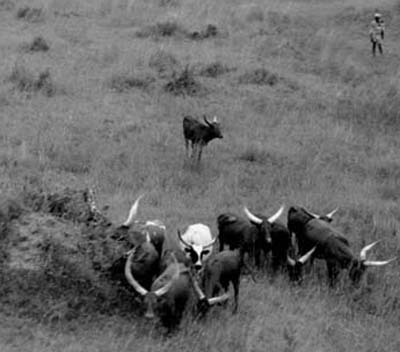


| Southwest Introduction
|
 This
included the District of Toro, located east of the Ruwenzori mountains;
the District of Ankole and in the extreme south west the mountainous district
of Kigezi. The rail line connecting the area with the rest of Uganda
and of East Africa ended at Kasese in Toro. Copper moved out
of Toro, Cattle largely out of Ankole, smaller lots out of Toro.
All three supplied labor for more economically active Uganda to the East.
Agriculture with few export crops was largely subsistence with
some production for local markets. There were several commercialization
efforts. A project to facilitate tea growing in Toro; another a
commercial fish processing plant at the north end of Lake George in Toro:
and a scheme for commercial cattle production in Ankole. These were
not major features of the agricultural landscape. The area as viewed from
Kampala and Jinja was remote.
This
included the District of Toro, located east of the Ruwenzori mountains;
the District of Ankole and in the extreme south west the mountainous district
of Kigezi. The rail line connecting the area with the rest of Uganda
and of East Africa ended at Kasese in Toro. Copper moved out
of Toro, Cattle largely out of Ankole, smaller lots out of Toro.
All three supplied labor for more economically active Uganda to the East.
Agriculture with few export crops was largely subsistence with
some production for local markets. There were several commercialization
efforts. A project to facilitate tea growing in Toro; another a
commercial fish processing plant at the north end of Lake George in Toro:
and a scheme for commercial cattle production in Ankole. These were
not major features of the agricultural landscape. The area as viewed from
Kampala and Jinja was remote.
South west Uganda was viewed largely by air. Settled areas of Toro and Ankole were traversed from the Semliki flats north of Fort Portal in Toro, south through settled Toro to Kasese; a lunch and fuel stop. The flight continued past the north end of Lake George and into Ankole; then south passing to the east of Bushenyi; further south for a further ten or so miles then turned east toward Mbarara another fuel stop and the major town of Ankole.
Flights by private aircraft were not allowed into Kigezi at that time. Both Kigezi and Ankole were visited by car. Air photo coverage was obtained for Kigezi from the Survey Department in Entebbe. These were detailed air photos taken for purposes of road realignment and or town planning. Several of these photographs are seen here. Main photo coverage for Kigezi was from the ground. The combination of views from air and ground demonstrate the surprisingly high percentage of land in cultivation in what at the time were the overcrowded landscapes of Kigezi.
© 2005 Uganda1963.org